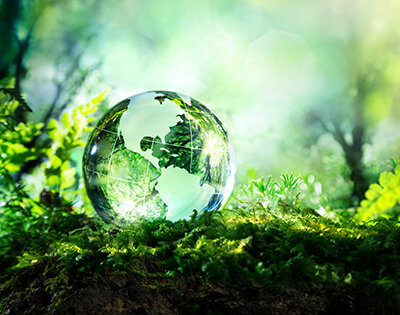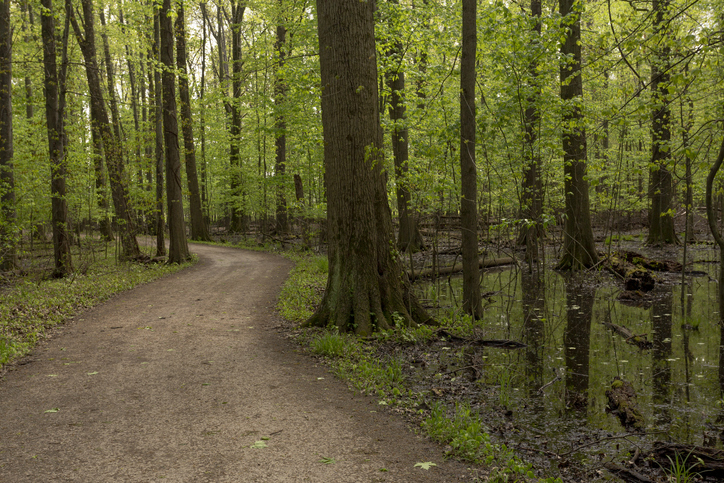Welcome to the Native Jungle, Where Local Birds and Bees Thrive
May 26, 2017
When you stop thinking about plants as pretty outdoor furniture on a green rug, and see them as complex organisms that feed thousands of beneficial insects, birds and mammals, your garden becomes another universe.
My husband and I moved up from an old farm property in Maryland to a sunny corner lot in the middle of Warren, R.I., a few years ago, and decided to devote most of the space to a large kitchen garden, surrounded by plants that would feed and shelter wildlife.
We kept some of the old plants that were here: a gnarled cedar tree, purple lilacs, a magnolia, and two purple smoke trees that edged the yard, as well as the horse chestnut and craggy catalpa near the house.
But we took out almost everything else: a couple of Japanese maples and peonies, German irises, hybrid tea roses, burning bushes, and a severely clipped row of yews alongside the house.
We dug up a good part of the lawn for our vegetable garden, another swath for prairie flowers such as Joe Pye-weed, ironweed and rudbeckias, and another for what must look like a collection of weeds — goldenrods, little bluestem, river oats, milkweed — and sticks — native viburnums, birch, beach plum, staghorn fern, high bush blueberry — to our neighbors, because they are still too young to look like anything else.
They can’t see what we see in our mind’s eye: these plants as they develop and fill in over the years, providing a lush and beautiful habitat for insects, birds and animals.
It’s easy to get inured to the grim statistics: 95 percent of the wilderness that once lay across the continental United States is now covered with cities and suburbs, 30 million acres of lawn, highways and malls, industrial parks, landfills, and many forms of agriculture.
That leaves just 5 percent for wildlife. No wonder half the bird species of 40 years ago have disappeared. Or that more than one-third of North American birds, 432 species, are at risk of extinction.
I’ve been gardening all my life, and writing about it for more than 30 years. I love my double French lilacs and fragrant Korean spicebush as much as anyone. But it wasn’t until I read Douglas W. Tallamy’s book Bringing Nature Home, first published in 2007, that it dawned on me. Most of these lovely sturdy beauties from other countries, hardly ever touched by disease or insects, don’t feed our native insects and birds. We are starving them with our pretty landscapes.
Because plants, insects and animals have co-evolved through the millennia, they have very specific relationships key to their survival. Many plants contain toxic or unpalatable compounds to keep from being eaten, but certain insect species, evolving with them, can digest those chemicals.
Butterflies lay their eggs on the leaves of plants that can be eaten by particular caterpillars, which in turn are snatched up by hungry birds who carry them off to feed their young.
These caterpillars are rich in fat and protein. “Like a steak for birds,” Tallamy, an entomologist, told me, the first time I talked to him for an article. I’d been planting natives for the bees and the birds for years, but I never really thought about caterpillars as burgers for birds.
Now Tallamy was telling me that 96 percent of terrestrial birds in North America eat insects, and their young can’t survive without them. And those native caterpillars only eat native plants.
Ever wonder why your Asian plants are so perfect? Nobody eats them. A Kousa dogwood, from China, for example, feeds no insects; a Florida dogwood supports 117 species of moths and butterflies.
I remember Tallamy, who teaches at the University of Delaware, give a talk at the Brooklyn Botanic Garden a few years ago, recounting how he walked around a native white oak in his Pennsylvania yard for half an hour. He’d come upon the oak seedling 14 years earlier. Now he circled the tree, 20 feet tall and 13 feet wide, counting the insects feeding on its leaves: 410 caterpillars, of 19 different species. (And don’t worry, he told those of us concerned about raggedy leaves; you could hardly see the holes.)
Another day, Tallamy counted the caterpillars on his black cherry trees: 239 of 14 species. In contrast, a Bradford pear in his neighbor’s yard had one species — an inchworm.
He spent another day watching a pair of chickadees feeding their young in a nesting box suspended from the young oak. The birds delivered 17 species of live caterpillars to their babies in three hours, sometimes carrying two or three at a time, every three minutes. They kept this up from 6 a.m.-8 p.m. for 16 days, until the nestlings fledged.
Once you understand the concept, you start gardening, as Tallamy says, “as if your life depended upon it.” (And it does, actually, when you think about what pollinators do, and trees do, and on an on, but to get back to my yard.)
I plant common milkweed for the monarch butterflies, which lay their eggs on the leaves. The caterpillars eat the leaves, which are toxic to most other insects, and become just as nasty-tasting as the leaves, so the birds won’t eat them.
I’ve planted native lupines for the endangered Karner blue butterfly, which not only sips nectar from the pea-like purple flowers, but lays her eggs on the soft light-green leaves.
Where we ripped up the yew hedge, we planted winterberry hollies, whose red berries don’t ripen until late winter, when there is little food for birds.
I continue to learn about such relationships from many sources, including the Rhode Island Wild Plant Society. I joined shortly after I moved here, to tag along with botanists and plant gurus on their many hikes into local wooded hills and marshes. I also joined one of the organization’s propagating teams, which grows plants from seed and cuttings. Many of these native shrubs and perennials have been hard to find in local nurseries. And if you do find bee balm, for example, it’s likely to come from the Midwest, not Rhode Island, or even southern New England, so it is not as highly adapted to local conditions.
If I sound like a plant geek, I am one. And if you’re in danger of becoming one, the Rhode Island Wild Plant Society is holding its annual plant sale June 3 from 9 a.m-1 p.m., rain or shine, at URI East Farm, Route 108, South Kingstown.
Anne Raver, a Warren, R.I., resident and longtime gardener, has written about landscape and the environment for more than 30 years.
Categories
Join the Discussion
View CommentsRecent Comments
Leave a Reply
Your support keeps our reporters on the environmental beat.
Reader support is at the core of our nonprofit news model. Together, we can keep the environment in the headlines.
We use cookies to improve your experience and deliver personalized content. View Cookie Settings




Hi Anne – this was a very nice posting. I say nice things about Doug Tallamy too, at the beginning of my native-edibles-focused slide shows, often called "Nibbling on Natives in Your Back Yard and Beyond". The point of these talks is that the fact that many of our native species are edible by people too provides a powerful additional incentive for people to plant then, who aren’t otherwise sufficiently motivated to do so for ecological reasons.
Here is a link to an online version of my native edibles slide show, which I presented several years ago at the RI Land and Water Summit: http://www.landandwaterpartnership.org/documents/Summit2013/EnhancingEdibilityofConservedLandscapes.pdf
Last but not least: here is a link to a list I have compiled on over 150 species of edible plants native to the northeast U.S.: : https://www.slideshare.net/RussCohen2/edible-wild-plant-species-native-to-the-northeast-us-and-eastern-canada-by-russ-cohen
While not all of these are native to Rhode Island, many of them are, and I am sure many of these will be available at RIWPS’ plant sale on Saturday.